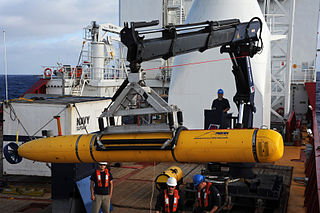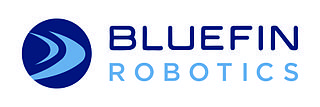
iRobot Corporation is an American technology company that designs and builds consumer robots. It was founded in 1990 by three members of MIT's Artificial Intelligence Lab, who designed robots for space exploration and military defense. The company's products include a range of autonomous home vacuum cleaners (Roomba), floor moppers, and other autonomous cleaning devices.

An autonomous underwater vehicle (AUV) is a robot that travels underwater without requiring continuous input from an operator. AUVs constitute part of a larger group of undersea systems known as unmanned underwater vehicles, a classification that includes non-autonomous remotely operated underwater vehicles (ROVs) – controlled and powered from the surface by an operator/pilot via an umbilical or using remote control. In military applications an AUV is more often referred to as an unmanned undersea vehicle (UUV). Underwater gliders are a subclass of AUVs.

An underwater glider is a type of autonomous underwater vehicle (AUV) that employs variable-buoyancy propulsion instead of traditional propellers or thrusters. It employs variable buoyancy in a similar way to a profiling float, but unlike a float, which can move only up and down, an underwater glider is fitted with hydrofoils that allow it to glide forward while descending through the water. At a certain depth, the glider switches to positive buoyancy to climb back up and forward, and the cycle is then repeated.

The Monterey Bay Aquarium Research Institute (MBARI) is a private, non-profit oceanographic research center in Moss Landing, California. MBARI was founded in 1987 by David Packard, and is primarily funded by the David and Lucile Packard Foundation. Christopher Scholin serves as the institute's president and chief executive officer, managing a work force of approximately 220 scientists, engineers, and operations and administrative staff.

A mobile robot is an automatic machine that is capable of locomotion. Mobile robotics is usually considered to be a subfield of robotics and information engineering.

Unmanned underwater vehicles (UUV), also known as uncrewed underwater vehicles and underwater drones, are submersible vehicles that can operate underwater without a human occupant. These vehicles may be divided into two categories: remotely operated underwater vehicles (ROUVs) and autonomous underwater vehicles (AUVs). ROUVs are remotely controlled by a human operator. AUVs are automated and operate independently of direct human input.

Kongsberg Maritime (KM) is a Norwegian technology enterprise within the Kongsberg Gruppen (KOG). Kongsberg Maritime deliver systems for positioning, surveying, navigation, and automation to merchant vessels and offshore installations. Their most well known products exist within dynamic positioning systems, marine automation and surveillance systems, process automation, satellite navigation, and hydroacoustics.
Subsea technology involves fully submerged ocean equipment, operations, or applications, especially when some distance offshore, in deep ocean waters, or on the seabed. The term subsea is frequently used in connection with oceanography, marine or ocean engineering, ocean exploration, remotely operated vehicle (ROVs) autonomous underwater vehicles (AUVs), submarine communications or power cables, seafloor mineral mining, oil and gas, and offshore wind power.
Oceaneering International, Inc. is a subsea engineering and applied technology company based in Houston, Texas, U.S. that provides engineered services and hardware to customers who operate in marine, space, and other environments.
AUV - 150 is an unmanned underwater vehicle (UUV) being developed by Central Mechanical Engineering Research Institute (CMERI) scientists in Durgapur in the Indian state of West Bengal. The project is sponsored by the Ministry of Earth Sciences and has technical assistance from IIT-Kharagpur.

The Sentry is an autonomous underwater vehicle (AUV) made by the Woods Hole Oceanographic Institution. Sentry is designed to descend to depths of 6,000 metres (20,000 ft) and to carry a range of devices for taking samples, pictures and readings from the deep sea.
The Knifefish is an autonomous unmanned underwater vehicle (UUV) under development by General Dynamics Mission Systems and Bluefin Robotics for the United States Navy. It is a propeller-driven minesweeping robot designed to replace the Navy's trained dolphins and sea lions after the retirement of the 50-year-old Marine Mammal Program in 2017. The Knifefish was first unveiled at a Navy exposition in April 2012, and was originally intended to operate in concert with the Navy's littoral combat ships (LCS) as part of a specialized counter-mine system.

JASCO Applied Sciences provides scientific consulting services and equipment related to underwater acoustics. JASCO operates from 7 international locations and provides services to the oil and gas, marine construction, energy, renewable energy, fisheries, maritime transport and defence sectors. The head office is located in Halifax, NS Canada. JASCO employs acousticians, bioacousticians, physicists, marine mammal scientists, engineers, technologists, and project managers.

The Bluefin-21 is an autonomous underwater vehicle (AUV) developed by Bluefin Robotics for defence, commercial or scientific use. It found its most famous use in April 2014 in the search for the wreckage of the missing Malaysia Airlines Flight 370.

Bluefin Robotics is an American robotics company, headquartered in Quincy, Massachusetts, which specialises in the design and manufacture of military and civilian autonomous underwater vehicles (AUVs) and related technology. The company was founded in 1997, and became a wholly owned subsidiary of Battelle Memorial Institute in 2005. Its products include the Bluefin-21 underwater search robot and its military derivative, the Knifefish minesweeping AUV, which entered service with the United States Navy in 2017. Bluefin was involved in the development of several advanced Navy projects, including the Black Pearl AUV and the Proteus optionally-manned submersible.
The Rainbowfish class bathyscaphe is a Chinese deep submergence vehicle under development in 2015 and originally scheduled to enter service in 2019, but has since been postponed after 2020.

Maya AUV is an autonomous underwater vehicle (AUV), developed by the Marine Instrumentation Division at the National Institute of Oceanography (NIO), India.

Ocean Infinity is a marine robotics company based in Austin, Texas, United States and Southampton, United Kingdom and was founded in 2017. The company uses robots to obtain information from the ocean and seabed.
Hadal ARV is a type of very little known unmanned underwater vehicle (UUV) built in the People's Republic of China (PRC). ARV stands for Autonomous Remotely-controlled Vehicle, an idea pioneered in China by Shenyang Institute of Automation (SIA) of Chinese Academy of Sciences (CAS), and SIA is also the developer of Hadal ARV and its predecessor Arctic ARV, as well as Hadal 1 ARV, the successor of Hadal ARV. Hadal and its predecessor Arctic series ARVs are the Chinese counterparts of Nereus hybrid unmanned underwater vehicle, because just like Nereus hybrid UUV, these ARVs can operate both as an AUV or a ROUV.
Autonomous Benthic Explorer (ABE) was a pioneering autonomous underwater vehicle (AUV) owned and operated by Woods Hole Oceanographic Institution (WHOI) in Woods Hole, Massachusetts. ABE was designed to perform wide-area seabed surveys at depths of up to 4500m (14,674ft) and completed 222 missions from 1996 until it was lost at sea in 2010. ABE pioneered the use of a relatively simple AUV to perform wide area surveys, identify points of interest, and “scout” for a more sophisticated manned vehicle or ROV.














